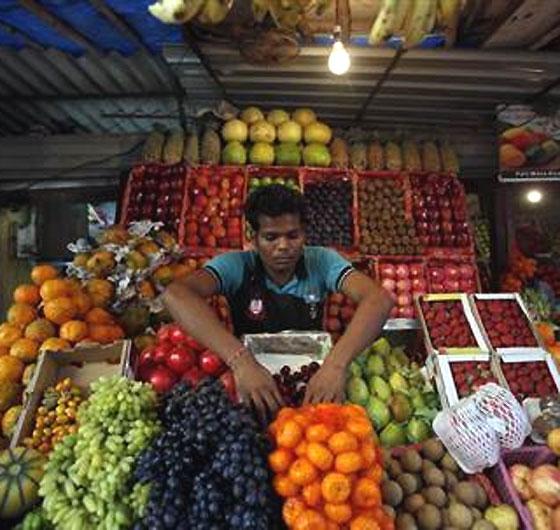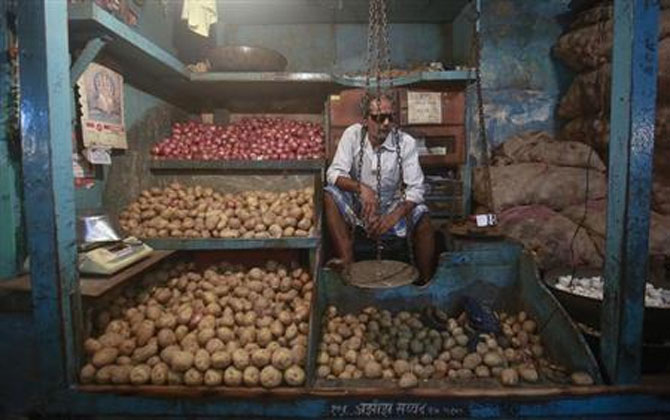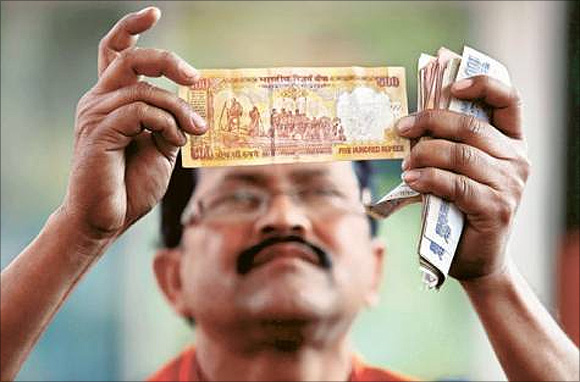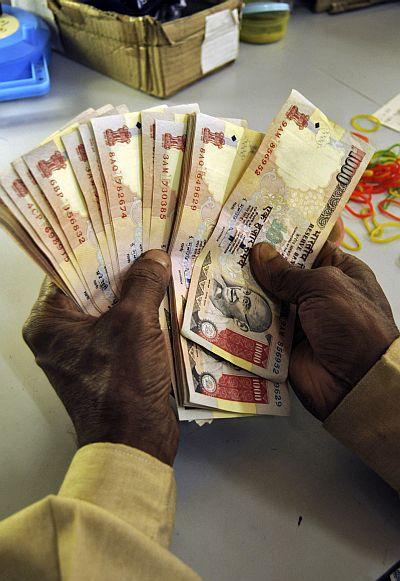Photographs: Vivek Prakash/Reuters Mayank Mishra in New Delhi
A 2005 Planning Commission report had arrived at a rather alarming conclusion that for every four rupees spent on the public distribution system, only one reached the intended beneficiary.
Following food inflation rising to 9.5 per cent in May, the government has announced a series of moves to address the matter.
These include asking states to crack down on hoarders and allow farmers to directly sell fruit and vegetables to consumers.
It is likely the Centre will release additional rice for the public distribution system.
With a sub-normal monsoon looming, the government is worried about spiralling food inflation and its debilitating impact on the nascent economic recovery.
The anxiety is understandable, as food inflation has hovered at about 10 per cent through the past seven years.
Click NEXT to take a look at five reforms that the government must consider:
5 steps to contain food inflation
Image: A labourer carries a packed basket of vegetables as a vendor waits for customers at his vegetables stall at a market in Kolkata May 14, 2012.Photographs: Rupak De Chowdhuri/Reuters
Calibrated rise in MSP
In the first five years of the last decade, the minimum support price for common paddy was increased from Rs 510 a quintal to Rs 560, a rise of about 10 per cent.
However, in the second half of the decade, the MSP saw growth of about 75 per cent.
In the case of wheat, while the MSP rise in the first half of the decade was a mere Rs 30, the second half saw an increase of Rs 450.
Other food items for which the government fixed MSP saw a similar trend.
Crops for which the government sets an MSP account for a third of the primary article basket in the Wholesale Price Index; food inflation has a weight of 47.6 per cent in the Consumer Price Index.
Any MSP-led increase in the prices of agricultural commodities, therefore, pushes up WPI and CPI in general, and food inflation in particular.
Recently, Reserve Bank Governor Raghuram Rajan had said, “Since minimum support prices are intended to be a floor for market prices, and have sometimes directly set the market price when increases have been substantial, for key crops, the rate of price inflation seems to relate to the increase in MSP in recent years.”
He, therefore, advocates ‘limiting the pace of MSP increases’.
. . .
5 steps to contain food inflation
Image: A vegetable vendor.Photographs: Danish Siddiqui/Reuters
APMC reform
If limiting the pace of increase in MSP will moderate the prices of wheat, rice and pulses, comprehensive reforms in regulated markets, also known as mandis, might arrest the price spiral for fruit and vegetables, another key component of food inflation.
Mandis owe their genesis to the Agricultural Produce Marketing Committees law, put in place by state governments to ensure the interests of farmers are protected and trade in agricultural items follows an order.
There are 7,246 mandis in India and the average area served by a mandi is 450 sq km. These mandis control almost the entire wholesale trade in agricultural goods.
There have been numerous reports on how distortions at mandis lead to a huge difference between the price a consumer pays and the price the producer gets.
A 2011 Indira Gandhi Institute of Development Research paper by Gokul Patnaik quotes research on the supply of fruit and vegetables in Delhi, Mumbai, Bengaluru and Kolkata and says, “On an average, there are five-six intermediaries between the primary producer and the consumer.
“The total mark-up in the chain adds up to 60-75 per cent.
“The primary producers receive only 20-25 per cent of the retail price.”
In the past, there have been attempts to reform the APMC law.
. . .
5 steps to contain food inflation
Photographs: Reuters
For a better system, the central government had formulated a model APMC Act in 2003. It permitted private and corporate bodies to set up a marketing network and demolish the well-entrenched mechanism of middlemen and arthiyas.
And, it allowed private mandis.
But the approach of state governments has been partial-adoption of some of these provisions.
Less than 10 per cent of trade in agricultural commodities takes place through private mandis.
Some states have allowed contract farming, while others have allowed direct purchase from farmers.
But comprehensive reform of the APMC legislation is yet to take place in any state.
Several attempts to delist fruit and vegetables from the purview of the APMC law, too, have yielded very little.
Aditi Nayar, senior economist at rating agency Icra, feels ‘a mechanism to build consensus with state governments for introducing appropriate amendments in APMC Acts is also crucial, particularly with a view to reducing middlemen and allowing contract farming’.
. . .
5 steps to contain food inflation
Photographs: Reuters
PDS reform
A 2005 Planning Commission report had arrived at a rather alarming conclusion that for every four rupees spent on the public distribution system, only one reached the intended beneficiary.
It had estimated 57 per cent food grains didn’t reach the targeted beneficiaries. Since then, the situation has improved somewhat.
But the leakage, according to authoritative estimates, is yet to fall below the 40 per cent level.
India has a network of about 478,000 fair price shops, catering to the needs of 400 million people.
They distribute, among other items, wheat, rice, sugar and kerosene oil.
Such a vast network of fair price shops would have done wonders to moderate the prices of essential commodities.
However, a leaking system has only added to the ballooning food burden without addressing the issues it was aimed at.
. . .
5 steps to contain food inflation
Image: The negative impact of the food security law enacted last year, on burgeoning subsidy bill, has been widely documented.Photographs: Reuters
Food security legislation
The negative impact of the food security law enacted last year, on burgeoning subsidy bill, has been widely documented.
What is even more worrisome is the impact it will have on the evolution of the country’s agricultural sector.
The share of the expenditure on cereals in overall food expenditure declined from 41 per cent in 1987-88 to 29.1 per cent in 2009-10 in rural regions and from 26.5 per cent in 1987-88 to 22.4 per cent in 2009-10 in urban areas.
However, the new food law will ensure there is excessive focus on production and procurement of low-value food items such as rice and wheat at the expense of high-value produce.
Will this not depress the already depressed agriculture sector?








article